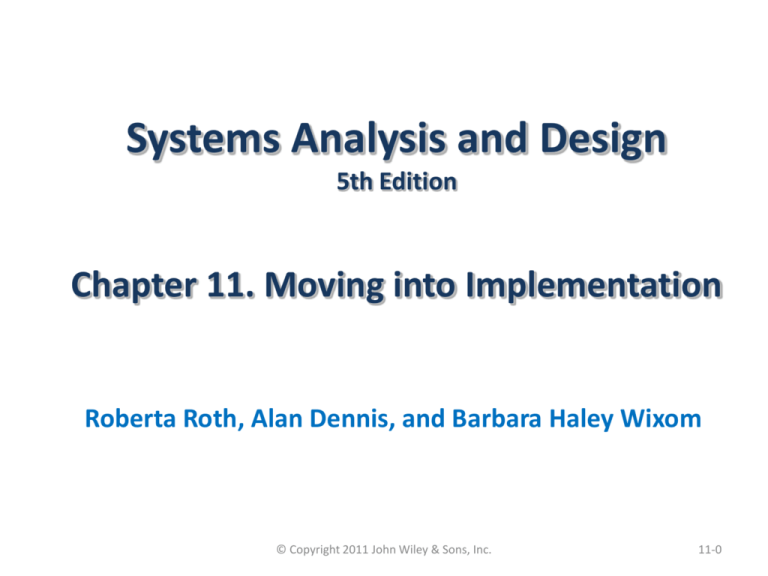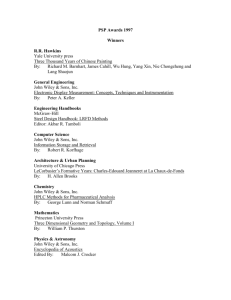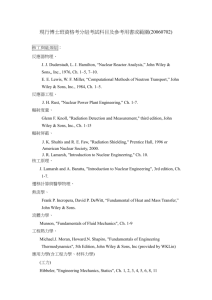
Systems Analysis and Design
5th Edition
Chapter 11. Moving into Implementation
Roberta Roth, Alan Dennis, and Barbara Haley Wixom
© Copyright 2011 John Wiley & Sons, Inc.
11-0
Chapter 11 Outline
Managing the programming
process.
Testing.
Developing documentation.
© Copyright 2011 John Wiley & Sons, Inc.
11-1
INTRODUCTION
The implementation phase consists of developing
and testing the system’s software, documentation,
and new operating procedures.
Managing the programming process is the major
task of the systems analyst in this phase.
While programmers work on programming, the
systems analyst design a variety of tests to ensure
that the system does what it was designed to do.
During this phase, the systems analysts finalize the
system documentation and develop the user
documentation.
© Copyright 2011 John Wiley & Sons, Inc.
11-2
MANAGING THE PROGRAMMING
PROCESS
The project manager’s tasks during
the process of programming:
- assigning programming tasks,
- coordinating the activities, and
- managing the programming
schedule.
© Copyright 2011 John Wiley & Sons, Inc.
11-3
Assigning Programming Tasks
The project manager first groups together modules
that are related, and then assigns the groups of
modules to programmers on the basis of their
experience and skill level.
The project manager must deal with a mismatch
between the available programming skills and the
programming skills that are needed for the project.
The best size of programming team is the smallest
feasible one that can function as independent as
possible.
© Copyright 2011 John Wiley & Sons, Inc.
11-4
Coordinating Activities
Coordination can be done through both high-tech
and low-tech means.
The simplest approach is to have a weekly project
meeting.
Another important method is to create and follow
standards.
Many project teams set up three “areas” for
programmers:
– development area,
– testing area, and
– production area.
© Copyright 2011 John Wiley & Sons, Inc.
11-5
(cont’d)
Implement change control techniques:
- keeping files and programs in different
places according to completion status,
- using a program log to keep track of
program changes.
Many CASE tools are set up to track the status
of programs and help manage programmers.
© Copyright 2011 John Wiley & Sons, Inc.
11-6
Managing the Schedule
The initial time estimates must be refined as
the project progresses during construction.
One of the most common causes for schedule
problems is scope creep.
Another common cause is unnoticed day-byday slippages in the schedule.
Typically, a project manager will create risk
assessment that tracks potential risks that
have an impact on the schedule and costs.
© Copyright 2011 John Wiley & Sons, Inc.
11-7
(cont’d)
Classic Implementation Mistakes:
1. Research-oriented development.
2. Using “low-cost” personnel.
3. Lack of code control.
4. Inadequate testing.
© Copyright 2011 John Wiley & Sons, Inc.
11-8
TESTING
The attention paid to testing is justified by the high
costs associated with downtime and failures caused
by software bugs.
© Copyright 2011 John Wiley & Sons, Inc.
11-9
Test Planning
Testing starts with the tester’s developing a test
plan that defines a series of tests that will be
conducted.
A test plan describes a set of very specific test
cases to examine, and defines the expected results.
The tester develops a series of test cases to ensure
that the quality of programs is validated.
There are four general stages of tests: unit tests,
integration tests, system tests, and acceptance
tests.
© Copyright 2011 John Wiley & Sons, Inc.
11-10
(cont’d)
Test plan
© Copyright 2011 John Wiley & Sons, Inc.
11-11
(cont’d)
Each of the functions is a separate
module that needs to be tested
© Copyright 2011 John Wiley & Sons, Inc.
11-12
(cont’d)
Error Discovery Rates for Different Stages of Tests
© Copyright 2011 John Wiley & Sons, Inc.
11-13
(cont’d)
Types of Tests
© Copyright 2011 John Wiley & Sons, Inc.
11-14
Unit Tests
Unit tests focus on one unit – a program or a
program module that performs a specific function
that can be tested.
There are two approaches to unit testing:
- Black-box testing
– The test plan is developed directly from the
program specification.
- White-box testing
– The tester reviews the actual program code.
© Copyright 2011 John Wiley & Sons, Inc.
11-15
Integration Tests
Integration tests assess whether a set of
modules or programs that must work
together do so without error.
There are four approaches to integration
testing:
- user interface testing,
- use scenario testing,
- data flow testing, and
- system interface testing.
© Copyright 2011 John Wiley & Sons, Inc.
11-16
System Tests
System tests are usually conducted by the systems
analysts to ensure that all modules and programs
work together without error.
System tests examine
- how well the system meets business requirements,
- usability,
- security,
- performance under heavy load, and
- system’s documentation.
© Copyright 2011 John Wiley & Sons, Inc.
11-17
Acceptance Tests
Acceptance tests are done primarily by the users.
The goal of acceptance tests is to confirm that the
system is complete, meets the business needs,
and is acceptable to the users.
Acceptance testing is done in two stages:
- alpha testing - users test the system using madeup data,
- beta testing – users begin to use the system with
real data and carefully monitor the system for
errors.
© Copyright 2011 John Wiley & Sons, Inc.
11-18
DEVELOPING DOCUMENTATION
There are two fundamentally different
types of documentation:
- system documentation is intended to help
programmers and systems analysts
understand the system and enable them to
build it or maintain it;
- user documentation is designed to help
the user operate the system.
© Copyright 2011 John Wiley & Sons, Inc.
11-19
(cont’d)
User documentation should not be
left until the end of the project.
Time required to develop and test
user documentation should be built
into project plan.
On-line documentation is becoming
the predominant form.
© Copyright 2011 John Wiley & Sons, Inc.
11-20
(cont’d)
There are four key strengths of online
documentation:
- Searching for information is simpler.
- The same information can be presented in
many different formats.
- It enables the user to interact with the
documentation in many new ways.
- It is significantly less expensive than paper
documentation.
© Copyright 2011 John Wiley & Sons, Inc.
11-21
Types of User Documentation
There are three fundamentally different types
of user documentation:
- Reference Documents are designed to be used
when the user needs to learn how to perform
a specific function.
- Procedural Manuals describe how to perform
business task.
- Tutorials teach people how to use major
components of the system.
© Copyright 2011 John Wiley & Sons, Inc.
11-22
Designing Documentation Structure
The general structure used in online
documentation is to develop a set of
documentation navigation controls that
lead the user to documentation topics.
There are five general types of navigation
controls for topics: table of contents, index,
text search, intelligent agent, and Web-like
links.
© Copyright 2011 John Wiley & Sons, Inc.
11-23
(cont’d)
Organizing Online Reference Documents
© Copyright 2011 John Wiley & Sons, Inc.
11-24
Writing Documentation Topics
Topics start with clear titles, followed by
introductory text that define the topic, and
then provide detailed, step-by-step
instructions.
Many topics include screen images and “show
me” examples.
Most also include navigation controls to
enable movement among topics.
Some also have links to related topics.
© Copyright 2011 John Wiley & Sons, Inc.
11-25
(cont’d)
A Help Topic in Microsoft Word
© Copyright 2011 John Wiley & Sons, Inc.
11-26
(cont’d)
Guidelines for Crafting Documentation Topics
© Copyright 2011 John Wiley & Sons, Inc.
11-27
Identifying Navigation Terms
Navigation terms are used to help users find
topics.
Terms for the index and search engine can come
from four distinct sources:
- The set of the commands in the user interface;
- The set of major concepts in the system (e.g., data
entities);
- The set of business tasks the user performs;
- The set of synonyms for the three sets of items
mentioned above.
© Copyright 2011 John Wiley & Sons, Inc.
11-28
SUMMARY
Managing programming
- The project manager assigns tasks to the programmers, coordinates
the program development, manages the schedule, and adjusts the
schedule.
Testing
- A test plan contains several tests.
- A test specifies several test cases.
- Four types of tests: unit tests, integration tests, system tests, and
acceptance tests.
Documentation
- User documentation and system documentation are moving towards
online documentation.
- Three types of user documentation: reference documents, manuals,
and tutorials.
© Copyright 2011 John Wiley & Sons, Inc.
11-29
Copyright 2011 John Wiley & Sons, Inc.
All rights reserved. Reproduction or translation of this work
beyond that permitted in Section 117 of the 1976 United States
Copyright Act without the express written permission of the
copyright owner is unlawful. Request for further information
should be addressed to the Permissions Department, John Wiley
& Sons, Inc. The purchaser may make back-up copies for his/her
own use only and not for redistribution or resale. The Publisher
assumes no responsibility for errors, omissions, or damages,
caused by the use of these programs or from the use of the
information contained herein.
© Copyright 2011 John Wiley & Sons, Inc.
11-30








